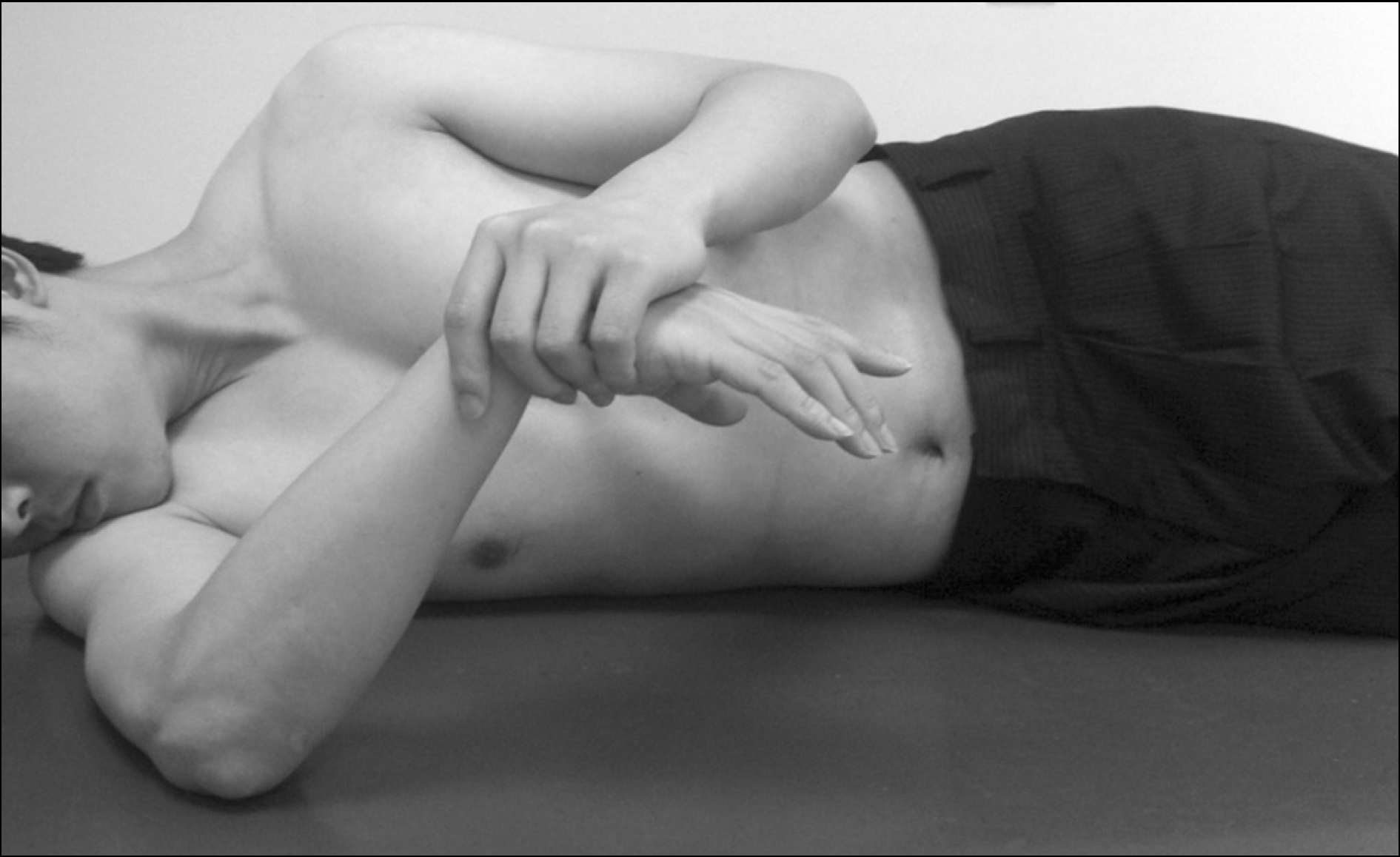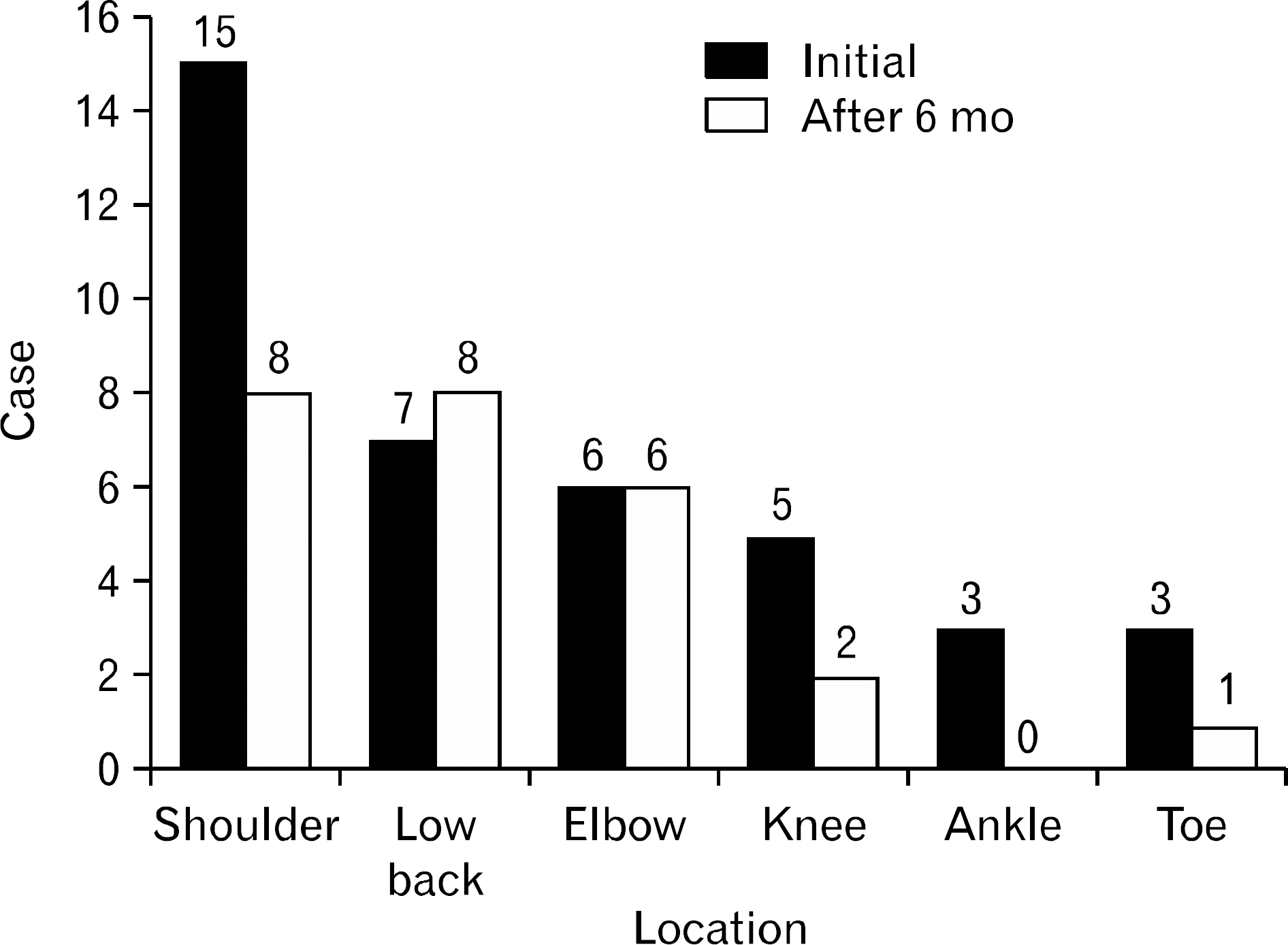Abstract
To investigate the effect of the glenohumeral internal rotation deficit (GIRD) improving rehabilitation program in high school baseball players on the change in muscle strength balance and pain of their shoulders. Seventy-six players (35 control group, 41 experimental group) participated in this 6-month study, from April, 2012 to September, 2012. The rehabilitation program (sleeper stretch) was carried out by coaches of experimental group. The experimental group showed a significant decrease, while the control group didn't show significant change in GIRD. The shoulder flexion-extension isokinetic strength ratio of experimental group changed only slightly, while that of control group experienced a bigger change. Experimental group players initially had high frequency of shoulder pain, but decreased to 53% at the end. Also, the Short Form-36 Health Survey showed the increase of total score. GIRD improving rehabilitation program helps to maintain the balance of shoulder extension-flexion strength ratio and relieve shoulder pain in the baseball players.
Go to : 
REFERENCES
1. Powell JW, Barber-Foss KD. Injury patterns in selected high school sports: a review of the 1995-1997 seasons. J Athl Train. 1999; 34:277–84.
2. Laudner K, Sipes R. The incidence of shoulder injury among collegiate overhead athletes. J Intercollegiate Sport. 2009; 2:260–8.

3. Yoon JS. A study on sport injuries of the baseball player's position [dissertation]. Seoul: Kookmin University;2006.
4. Crockett HC, Gross LB, Wilk KE, et al. Osseous adaptation and range of motion at the glenohumeral joint in professional baseball pitchers. Am J Sports Med. 2002; 30:20–6.

5. Osbahr DC, Cannon DL, Speer KP. Retroversion of the humerus in the throwing shoulder of college baseball pitchers. Am J Sports Med. 2002; 30:347–53.

6. Wilk KE, Meister K, Andrews JR. Current concepts in the rehabilitation of the overhead throwing athlete. Am J Sports Med. 2002; 30:136–51.

7. Braun S, Kokmeyer D, Millett PJ. Shoulder injuries in the throwing athlete. J Bone Joint Surg Am. 2009; 91:966–78.

8. Burkhart SS, Morgan CD, Kibler WB. The disabled throwing shoulder: spectrum of pathology Part I: pathoanatomy and biomechanics. Arthroscopy. 2003; 19:404–20.

9. Sethi PM, Tibone JE, Lee TQ. Quantitative assessment of glenohumeral translation in baseball players: a comparison of pitchers versus nonpitching athletes. Am J Sports Med. 2004; 32:1711–5.
10. Burkhart SS, Morgan CD, Kibler WB. The disabled throwing shoulder: spectrum of pathology. Part II: evaluation and treatment of SLAP lesions in throwers. Arthroscopy. 2003; 19:531–9.

11. Kuhn JE, Lindholm SR, Huston LJ, Soslowsky LJ, Blasier RB. Failure of the biceps superior labral complex: a cadaveric biomechanical investigation comparing the late cocking and early deceleration positions of throwing. Arthroscopy. 2003; 19:373–9.

12. Jobe CM. Posterior superior glenoid impingement: expanded spectrum. Arthroscopy. 1995; 11:530–6.

13. Noffal GJ. Isokinetic eccentric-to-concentric strength ratios of the shoulder rotator muscles in throwers and nonthrowers. Am J Sports Med. 2003; 31:537–41.

14. Kibler WB. The relationship of glenohumeral rotation deficit to shoulder and elbow injuries in tennis players: A prospective evaluation of posterior capsular stretching. The 14th Annual Closed Meeting of the American Shoulder and Elbow Surgeons. 1998. Nov 5-8; New York, USA. St Louis, MO: Mosby; 1998.
15. Whiteley R, Ginn K, Nicholson L, Adams R. Indirect ultrasound measurement of humeral torsion in adolescent baseball players and non-athletic adults: reliability and significance. J Sci Med Sport. 2006; 9:310–8.

16. Jenkinson C, Stewart-Brown S, Petersen S, Paice C. Assessment of the SF-36 version 2 in the United Kingdom. J Epidemiol Community Health. 1999; 53:46–50.

17. Cook EE, Gray VL, Savinar-Nogue E, Medeiros J. Shoulder antagonistic strength ratios: a comparison between college-level baseball pitchers and nonpitchers. J Orthop Sports Phys Ther. 1987; 8:451–61.

18. Ivey FM Jr, Calhoun JH, Rusche K, Bierschenk J. Isokinetic testing of shoulder strength: normal values. Arch Phys Med Rehabil. 1985; 66:384–6.
19. Hughes RE, Johnson ME, O'Driscoll SW, An KN. Normative values of agonist-antagonist shoulder strength ratios of adults aged 20 to 78 years. Arch Phys Med Rehabil. 1999; 80:1324–6.

20. DiFiori JP, Benjamin HJ, Brenner JS, et al. Overuse injuries and burnout in youth sports: a position statement from the American Medical Society for Sports Medicine. Br J Sports Med. 2014; 48:287–8.

21. Shanley E, Thigpen C. Throwing injuries in the adolescent athlete. Int J Sports Phys Ther. 2013; 8:630–40.
22. Scher S, Anderson K, Weber N, Bajorek J, Rand K, Bey MJ. Associations among hip and shoulder range of motion and shoulder injury in professional baseball players. J Athl Train. 2010. 45:191–7.
23. Wilk KE, Macrina LC, Fleisig GS, et al. Correlation of glenohumeral internal rotation deficit and total rotational motion to shoulder injuries in professional baseball pitchers. Am J Sports Med. 2011; 39:329–35.

24. Shanley E, Rauh MJ, Michener LA, Ellenbecker TS, Garrison JC, Thigpen CA. Shoulder range of motion measures as risk factors for shoulder and elbow injuries in high school softball and baseball players. Am J Sports Med. 2011; 39:1997–2006.

25. Grossman MG, Tibone JE, McGarry MH, Schneider DJ, Veneziani S, Lee TQ. A cadaveric model of the throwing shoulder: a possible etiology of superior labrum anterior-toposterior lesions. J Bone Joint Surg Am. 2005; 87:824–31.
26. Laudner KG, Sipes RC, Wilson JT. The acute effects of sleeper stretches on shoulder range of motion. J Athl Train. 2008; 43:359–63.

27. Edouard P, Degache F, Oullion R, Plessis JY, Gleizes-Cervera S, Calmels P. Shoulder strength imbalances as injury risk in handball. Int J Sports Med. 2013; 34:654–60.

Go to : 
 | Fig. 1.Sleeper stretch exercise. The players lie on the throwing shoulder side with glenohumeral joint flexed at 90o, with a 90o internal rotation, and the elbow was flexed at 90o. They hold their wrist with the opposite hand and slowly push the forearm towards the floor. |
 | Fig. 2.The frequency of pain location in the experimental group was assessed through a survey, conducted at the commencement of the rehabilitation program, and after 6 months. The incidence of shoulder pain decreased from 15 to 8 cases (a 53% decrease) after 6 months. |
Table 1.
Demographic characteristics of subjects
Table 2.
Initial shoulder ROM of internal rotation and external rotation
| Group | Internal rotation (o) | External rotation (o) | ||
|---|---|---|---|---|
| T-shoulder | NT-shoulder | T-shoulder | NT-shoulder | |
| Experimental group | 40.97±17.90∗ | 47.53±14.63∗ | 107.56±10.45∗ | 98.76±10.48∗ |
| Control group | 37.68±11.90∗ | 47.66±11.91∗ | 107.18±9.29∗ | 100.03±8.67∗ |
Table 3.
The glenohumeral internal rotation deficit (GIRD)
| Group | GIRD (o) | |
|---|---|---|
| Initial | After (°) | |
| Experimental group | 15.5±2.34 | 7.14±2.60∗ |
| Control group | 12.94±2.06 | 11.94±4.75 |




 PDF
PDF ePub
ePub Citation
Citation Print
Print


 XML Download
XML Download